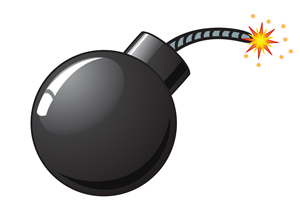
Cash in NBA GPP’s
Cashing isn’t easy in fantasy basketball GPPs. Unlike a double-up or head-to-head, where half the field wins and the payout is the same across the board, tournaments have a top-heavy payout structure. Up to 20% of the field receives a piece of the prize pool, but most of the cash goes to the top 5%.
And most of THAT cash goes to the top 10 winners.
That’s the reality that should inform your draft strategy.
Large-field tournaments seldom reward the risk-averse team owner. Smart risk-taking is king and variance reigns supreme.
We’ve already talked about how to build winning lineups for cash games. Today, we’re going to focus on creating rosters designed to give you the best possible chance of cashing in guaranteed prize pool contests. Here are some of the concepts we’ll cover below:
– Defensive efficiency
– Team pace
– Defense vs. position
– Upside and variance
– Elite players
*Check out NBA specific DFS tool, FantasyCruncher for maximizing lineups values!
That’s a hefty agenda, so let’s not waste any time.
Defensive Efficiency: A Key To Identifying Teams To Avoid
Defensive efficiency is a macro statistic. It represents the effectiveness of a team’s defense; it indicates the average number of points that team allows for every 100 possessions. The number will reveal which teams you should avoid when rostering players on the other side of the ball.
For example, the Golden State Warriors are currently leading the field in terms of defensive efficiency. They allow fewer points per 100 possessions than every other NBA team.
Let’s suppose the Warriors are playing the 76ers. Given the effectiveness of the Warriors’ defense, you’d want to avoid drafting players from the latter team, even if they have a solid track record. Joel Embid, Jimmy Butler and JJ Redick, all of whom are good players, are likely to have trouble scoring against the Warriors.
Like every statistic, there’s a flip side to the equation: defensive efficiency also reveals teams that are having trouble defending positions. For instance, Cleveland currently has one of the worst defensive records of the season. If they were playing the Atlanta Hawks, you’d expect guys like John Collins and Trae Young to have a great night.
You can find defensive efficiency stats for each team at ESPN.
Pace Factor: Fast Vs. Slow Teams And Why You Should Care
Pace is another macro stat. It reflects the average number of possessions a team makes per game. More possessions translates into more scoring opportunities. That being the case, you’d want to concentrate on guys playing on teams that maintain a high pace factor.
For example, consider the Milwaukee Bucks. They’re one of the fastest-paced teams this season. Hence, power guard Brandon Knight, shooting guard Giannis Antetokounmpo and small forward Khris Middleton are likely to get a disproportionate number of chances to score. The effect is even more pronounced if they play a team that maintains a lower pace factor (for instance, the Brooklyn Jets).
Find pace stats for each team at the same place you found defensive efficiency stats.
Defense Vs. Position: How To Find Promising Matchups
If defensive efficiency and pace factor are “macro” stats, defense vs. position (DvP) is a “micro” stat. It signifies how well a team defends a given position. It can reveal matchups that are likely to hamper or benefit your roster’s production.
For example, let’s say you need to fill a small forward position. The San Antonio Spurs have been adept at locking down small forwards this season. If the Spurs are playing the Pacers, you’d want to fade guys like C.J. Miles and Solomon Hill.
By contrast, the Denver Nuggets have had a lot of difficulty closing down small forwards. If the Nuggets are playing Oklahoma City, Kevin Durant is likely to be one of the best investments you can make.
Go through each contest on the schedule and compile DvP numbers for every team. Fair warning: it’s going to take time and effort. But that just means a lot of your competition won’t bother doing the work.
The Need For Upside: Why It’s Critical In NBA GPPs

Want someone who can go “Boom”
Upside represents scoring potential. It’s a key factor in creating rosters that win GPPs.
We noted earlier that large-field tournaments pay out the majority of the prize pool cash to the top 5% of the field. That means you need a lineup that beats 95% of your opponents. Safe, stable NBA players who turn in a consistent number of points each game aren’t going to be enough to win. You need guys who will exceed expectations. You need boom-or-bust players.
Being able to take calculated risks is a crucial skill in winning GPPs. You have to be comfortable giving up stability for uncertainty. That’s the only way you’ll have a chance to outscore your competition.
Where To Look For Upside In Daily Fantasy Basketball
A lot of daily fantasy NBA fans instinctively think of bench players when it comes to identifying guys with upside. The idea is to pick up 2nd-tier guys who are overlooked. The problem is, bench players rarely get enough minutes to turn in the points you need to win a large-field contest.
You need starters.
The small forward is going to give you the greatest upside potential. Small forwards are incredibly versatile. They not only log a high number of field goals, but routinely score points through rebounds, steals and assists.
That’s important. One of the first things you’ll notice about daily fantasy basketball is that buckets scored is a pretty consistent statistic. Guys like Kevin Durant, Carmelo Anthony and Gordon Hayward are dependable in terms of their respective field goal percentages. There isn’t much upside in that category.
But there’s considerable upside when it comes to rebounds, assists, blocks and steals.
To demonstrate, take a look at Carmelo Anthony’s record. In a recent game, he turned in 1 rebound, 1 assist, 1 block and 0 (zero) steals. The next game, he delivered 10 rebounds, 3 assists and 2 steals. That represents a huge difference in fantasy points.
That’s the type of upside you need in order to win an NBA GPP.
See this guide to finding value in the NBA schedule for some ideas on finding upside.
Seeding Your Roster With A Point-Producing Machine
You need at least one elite player – and preferably two – in your roster. In large-field tournaments, guys like LeBron James and Russell Westbrook can serve as the backbone of your roster. If one of your other picks falls short, delivering fewer fantasy points than you anticipated, your elite player’s performance can make up the difference.
At FanDuel, you’ll need approximately 300 points to finish in the top 5% of the field (that’s a very rough estimate). That translates into 33 points per player (FanDuel requires a 9-player lineup). If one of your players logs only 25 points for the night, having King James or Westbrook in your lineup might save your skin. Consider that Westbrook recently turned in 80 fantasy points against New Orleans. That kind of production is worth every salary dollar you spend.
Injuries And Late Scratches: Double-Check Your Lineups
We’ve talked before about the importance of making sure your draft picks are actually going to spend time on the court. But it bears repeating. Don’t take for granted that a player who is scheduled to play will actually do so. He might be sidelined at the last moment by an injury. Or he may develop an unexpected illness that keeps him off the court.
Needless to say, a player whose sneakers never touch the hardwood won’t be able to contribute to your roster’s score. His lack of production will demolish your chances of finishing at the top of the field.
Thirty minutes before the first tip-off, double-check the latest NBA injury report to see whether any of your players are listed. If they are, replace them.
It’s also a good idea to search Twitter for your players’ names (use Twitter’s advanced search function). If someone is a late scratch, Twitter is the best place to find the latest details.
Playing It Safe Vs. Taking Risks In NBA GPP Contests
Winning large-field fantasy basketball tournaments is about taking risks. Stability and safety are overrated. You need boom-or-bust players who will exceed expectations and give wings to your roster’s score.
The good news is that you can take calculated risks that are informed by data. Here’s a quick summary of the steps…
1. Look up each team’s defensive efficiency and pace factor for the season.
2. Drill down into each team’s DvP stats.
3. Identify players who offer a lot of upside. Focus on starting small forwards.
4. Select one or two elite players.
5. Double-check for injuries and late scratches.
If you take those 5 steps, you’ll be ahead of most of your opponents in the next guaranteed prize pool basketball tournament. While other team owners play it safe, you’ll have an opportunity to catapult ahead of them and grab a healthy chunk of the prize pool.
Keep On Reading
- This weeks NBA Vegas Odds
- All NBA content
- Fantasy Golf is my favorite fantasy sport that I love to hate.
- Using NBA Vegas Lines To Your Advantage
- Advanced NBA Stats To Put To Use